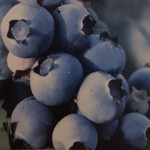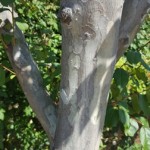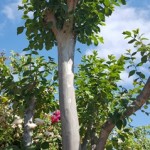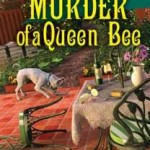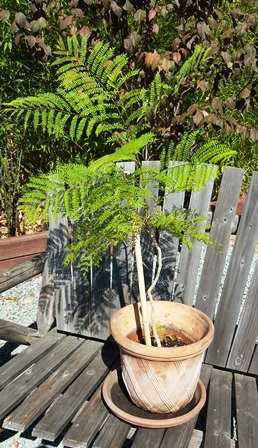Backyard Blueberries Taste Delicious and Are Easy to Grow
What’s not to love about blueberries. They’re almost a a perfect fruit. They are delicious, packed full of antioxidants, easy to grow, and add lovely landscape interest to any garden.
Grow blueberries in containers or in the ground but keep in mind that these plants like well-drained acidic soil. The pH should be on the low side, ranging from 4.5 to 5.5.
In the hottest inland valleys of the Bay Area, blueberries do best with morning sun and shade for hot afternoons. Northern Highbush varieties require winter chilling (800 to 1000 chill hours) to get the plants to produce fruit. Southern Highbush blueberries require from 700 to 1000 chill hours.
These plants benefit from an organic fertilizer with nitrogen.
Hold off on pruning for up to three years, allowing the plant to develop both a strong root system and bushy foliage. New plants begin to produce berries around the third year. During the third year, start pruning twice a year to remove inner and crossing branches to let in light and reduce the possibility of foliage disease.
Of the dozens of varieties of blueberries on the market today, among the Southern Highbush types is an early cultivar known as Misty. It produces a medium to large berry that is both sweet and spicy. The bush is upright with leaves that are blue-green turning to burgundy in autumn.
Sharpblue is another Southern Highbush variety that needs only 200 chill hours and produces dime-size fruit in abundance. The leaves remain green through fall and the bush is an outstanding specimen with high ornamental value in any garden.
For exceptional large berries with a robust flavor, give Southmoon a try. The berries are sweet; the plant, upright and vigorous. The plant will require 400 chill hours and will perform best in a sandy soil with lots of organic matter.
Whether you like your blueberries picked from the bush to eat fresh or baked into a delicious pie, give this plant a try. If you provide your blueberry plant the nutrients, sunlight, and water it requires, it will reward you with luscious fruit year after year.
_____________________________________________________
Order a copy of The Self-Care Planner for ideas about how to care for yourself. https://www.simonandschuster.com/books/The-Self-Care-Planner/Meera-Lester/9781507211649

Check out the Henny Penny Farmette series of cozy mysteries. Available for purchase from online and traditional bookstores everywhere
Transplanting a Decades-Old Crape Myrtle Tree
Friends said it was a bad idea. The tree was too large, too old, and too unwieldy to dig up and transport from my daughter’s property to mine. The crape myrtle would not survive, they told me, because its large root would need to be severely cut. Also, without a crane or other lifting device, three of us would be struggling to deal with such a heavy tree.
I won’t say moving the tree was easy. It had been standing for 28 years next to my daughter’s house, but she wanted to make way for new landscaping. When the family decided to part with the tree, they called on a family friend who worked as an arborist. He would do the cutting and digging of the tree.
Crape myrtles (of the genus, lagerstoemia) are available as shrubs and trees and are lovely in bloom with showy paniculate flowers in pink, fuchsia, red, or lavender. They are one of the trees that make little-to-no pollen (great for allergy sufferers). Light pruning during the growing season can produce a second bloom. Much beloved in the deep south, these trees remain stately and beautiful for up to fifty years.
My daughter’s tree arrived at the farmette in mid-October strapped onto our friend’s truck. The roots had been cut away. There were no fine root hairs or stems left–just bare wood. Ditto for the tree canopy–just a few hefty branch stubs. I wondered if our efforts would prove futile.
Hubby and I prepared a large planting hole just off from the patio. We added amendments to the clay soil and drove in stakes to keep the tree stable for a year or more until it had sufficiently developed roots. I added root hormone to the soil and watered deeply the first day and several times that week.
The winter rains came. I watched, waited, and wondered if there would ever be sprouting of any kind on the woody ends where branches had been amputated. Despite a canopy, the tree’s trunk, a beautiful, gray-green wood, afforded a kind of beauty to the austere winter garden. Before spring, I scraped a fingernail on the back of the trunk and discovered the wood was not dried out but as green and moist as a young sapling.
A spell of warm weather and the buzzing of bees in early spring drew my attention upward. Our tree had sprouted a flurry of bronze-green leaves. Pink blooms will likely appear in June or July.
I’m happy now that we went to all the trouble of bringing that tree onto the farmette for transplanting. We’ll have lovely pink blooms over the remaining summers of my life thanks to the crape myrtle tree being so long-lived.
__________________________________________________________________
If you enjoy reading about gardening and farming topics, check out my Henny Penny Farmette series of mysteries: A BEELINE TO MURDER, THE MURDER OF A QUEEN BEE, and A HIVE OF HOMICIDES (Kensington Publishing).
Each book is chocked full of tips for gardening, keeping bees and chickens, and growing heirloom fruits and vegetables. There are also plenty of delicious recipes to try. Find these books on Amazon.com, Barnes & Noble.com, Walmart.com and other online retailers or purchase at traditional bookstores everywhere.–Meera Lester
Winter Solstice Day
It’s that time of the year when we mark the shortest day of the year, the beginning of winter, and the return of the light. I like to think of it as a day when I decide what I do and don’t want to take with me into the coming New Year.
We’ve had a run of cold nights with temperatures in the upper 20 degrees Fahrenheit. But the light will soon return and warm the Earth. Late January-early February marks the beginning of bare-root season. My work now includes pruning and spraying and clearing out the old to make way for rebirth and renewal.
Among the plants that renew are the fruit trees. The pruned branches, garden clippings, and old vines are being recycled into compost for next spring’s garden. Come late spring, I’ll have trees with gorgeous canopies and tons of fruit to make into jam.

This DIY birdhouse is crafted from a repurposed fence board. Not all birds will take up residence in a house, but many will.
Garlic and onions are growing now and will through the winter months, thanks to our mild Mediterranean climate. But there is so much cleanup of the property that needs doing, I can only hope to start that today.
I’m putting out seed balls for the birds as well as refilling feeders and suet holders. Easy-to-find food keeps our feathered songsters around through spring when they start their families. For directions on making a birdhouse for your garden, check out https://hobbyreads.wordpress.com/category/crafts.
*******************************************************************************************************************************************************
Enjoy reading about farming topics? Check out my cozy mysteries–A BEELINE TO MURDER and also THE MURDER OF A QUEEN BEE (both in the Henny Penny Farmette series from Kensington Publishing).
JOIN THE CHRISTMAS EVE FUN–Read a short excerpt from my newest book, THE MURDER OF A QUEEN BEE and check out blogger Brooke Bumgardner’s interview of me at http://www.brookeblogs.com
My farmette and bee-based novels are chocked full of recipes, farming tips, chicken and beekeeping tips, sayings and, of course, a charming cozy mystery. For more info, click on the links under the pictures.
The books are available through online retailers such as Amazon, Barnes & Noble, Target, BAM, Kobo Books, and Walmart as well as from traditional bookstores everywhere.
See, http://tinyurl.com/hxy3s8q
This debut novel launched the Henny Penny Farmette series of mysteries and sold out its first press run. It’s now available in mass market paperback and other formats.
See, http://tinyurl.com/h4kou4g
NEWLY RELEASED! This, the second cozy mystery in the Henny Penny Farmette series, is garnering great reviews from readers and industry publications. Get your copy while you can. It’s sure to sell out like novel #1.
A Forty-foot Tall Brazilian Beauty
We recently lost the elm tree that stood about 25 feet tall next to the small house on our Henny Penny Farmette. On hot days, we really feel the heat now that the elm’s shady canopy is gone. Among the trees we are considering as a replacement for the elm is a Jacaranda mimosaefolia.
This Brazilian beauty will grow to 40 feet tall and spread from 15 to 30 feet wide. The trees begin to branch profusely when they reach about 6 feet high. I love the fernlike leaves and the 8-inch long clusters of bluish-lavender tubular flowers. The tree blooms abundantly in June and is stunning in any landscape or garden.
The trees will tolerate a wide variety of soil types. Water must be consistent but too much will create profuse tender growth and too little will stunt the tree. We purchased two of these gorgeous trees and will plant them at the front of our home, far enough away from each other to allow them to mature without crowding.
Although I will miss the elm shade until the jacarandas grow large, I won’t miss the debris of seed pods and small branches easily fractured from the elm. Mature Jacaranda’s in full bloom are a sight to behold and they’re fairly easy to grow.
* * *
If you enjoy reading about farmette topics (including gardening, beekeeping, and delicious recipes), check out my cozy mysteries A BEELINE TO MURDER and also THE MURDER OF A QUEEN BEE in the Henny Penny Farmette series (from Kensington Publishing).
Enter the Goodreads Giveaway–September 29 to October 6–for a chance to win a signed copy of a first-edition hardcover of The Murder of a Queen Bee. Three lucky winners will be chosen.
These novels are chocked full of recipes, farming tips, and sayings as well as a charming cozy mystery.
The books are available through online retailers such as Amazon, Barnes & Noble, Kobo Books, and Walmart as well as from traditional bookstores everywhere.
See, http://tinyurl.com/hxy3s8q
This debut novel launched the Henny Penny Farmette series of mysteries and sold out its first press run. It’s now available in mass market paperback and other formats.
See, http://tinyurl.com/h4kou4g
Release date is THIS WEEK–September 27. This book, the second cozy mystery in the Henny Penny Farmette series, is garnering great reviews on Goodreads.com.
It’s available free on Net Galley (netgalley.com) for readers, bloggers, and other professionals who write reviews.
 Facebook
Facebook Goodreads
Goodreads LinkedIn
LinkedIn Meera Lester
Meera Lester Twitter
Twitter




